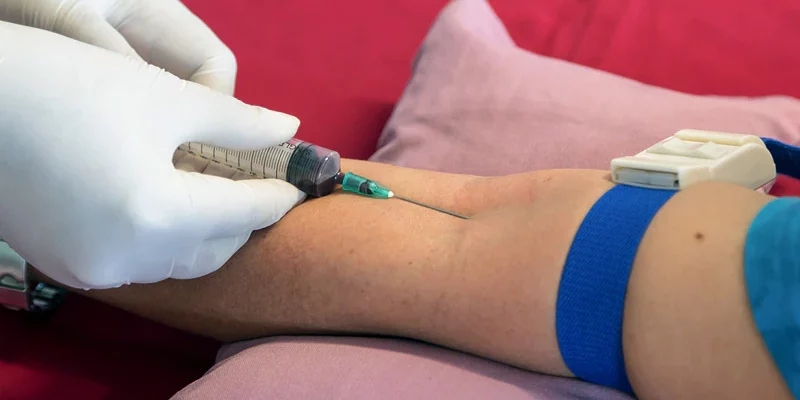A new blood-based biomarker panel combined with a model assessing risk factors of lung cancer better predicted who could benefit most from lung cancer screening, according to new findings.
The biomarker-based panel alongside a lung cancer risk prediction model (PLCOm2012) was more sensitive and specific than the expanded 2021 screening criteria issued by the US Preventive Services Task Force (USPSTF), which included lowering the start age for screening from 55 to 50 years and the requirements for smoking history from 30 to 20 pack-years.
Among individuals who had at least a 10 pack-year smoking history, the combination model demonstrated a sensitivity of 88.4%, compared to 78.5% for the USPSTF criteria. Specificity was also better, favoring the combination model (56.2% vs 49.3%).
“Our study shows for the first time that a blood test could be useful to determine who may benefit from lung cancer screening,” study author Sam Hanash, MD, PhD, professor of clinical cancer prevention and leader of the McCombs Institute for the Early Detection and Treatment of Cancer at the University of Texas MD Anderson Medical Center, said in a statement.
The study was published online January 7 in the Journal of Clinical Oncology.
The National Lung Screening Trial reported that screening high-risk individuals with low-dose computed tomography (LDCT) reduces lung cancer–related deaths by 20%. The 2021 updated guidelines from the USPSTF recommend LDCT screening for individuals between age 50 and 80 who have a smoking history of at least 20 pack-years and currently smoke or have quit within the past 15 years.
However, the USPSTF criteria were given a B recommendation, and experts noted that more research was needed to improve uptake of LDCT screening and develop biomarkers to better identify people who could benefit.
“We recognize that a small percentage of people who are eligible for lung cancer screening through an annual low-dose CT scan are actually getting screening, and moreover, CT screening is not readily available in most countries,” Hanash said. “Our goal, for many years, has been to develop a simple blood test that can be used first to determine need for screening and make screening for lung cancer that much more effective.”
The risk model — known as the Prostate, Lung, Colorectal and Ovarian (PLCO) Cancer Screening Trial control group (PLCOm2012) — can predict the 6-year risk of lung cancer among smokers or former smokers.
To improve risk profiles, Hanash and colleagues found that a four-marker protein panel (4MP) — consisting of the precursor form of surfactant protein B (Pro-SFTPB), cancer antigen 125, carcinoembryonic antigen, and cytokeratin-19 fragment — could potentially identify individuals at risk for developing lung cancer better than Pro-SFTPB alone.
In the current study, the authors explored whether combining the blood-based four-marker protein panel with the PLCOm2012 model could better identify individuals who would benefit from lung cancer screening compared to the USPSTF criteria.
The authors performed a blinded validation study using PLCO Cancer Screening Trial data and biospecimens to evaluate the performance of the four biomarkers. The assessment consisted of 552 case patients, for whom 1299 serial sera were collected within 6 years of diagnosis, and 2193 non-case patients, for whom 8709 serial sera were collected.
The 4MP alone yielded an area under the receiver operating characteristic curve (AUC) of 0.79 for specimens drawn from lung cancer cases obtained within 1 year before diagnosis and 0.74 for the entire specimen set. The combined 4MP and PLCOm2012 model yielded an AUC of 0.85 for lung cancer specimen that had been collected within 1 year prior to diagnosis.
The combined model showed improved sensitivity at high specificity. Compared to the USPSTF 2021 criteria, the combined model exhibited statistically significant improvements in both sensitivity (88.4% vs 78.5%) and specificity (56.2% vs 49.3%).
For participants with a smoking history of at least 10 pack-years, the 4MP plus PLCOm2012 model would have identified 9.2% more lung cancer cases for annual screening and reduced referral by 13.7% among non-cases, compared to USPSTF 2021 criteria.
The authors note that while the blood test could be implemented as a lab test in the near future, approval from the US Food and Drug Administration would most likely require evaluation through a prospective clinical trial.
“[This] blood test would identify people who could benefit from lung cancer screening but are not eligible today,” Hanash said. “Tens of millions of people worldwide could benefit from lung cancer screening. If you can improve screening eligibility by even 5%, that is incredibly impactful.”
The study was supported by NIH grants to several of the co-authors and Cancer Prevention & Research Institute of Texas and philanthropic contributions to the University of Texas MD Anderson Cancer Center Moon Shots Program and the Lyda Hill Foundation. Hanash is an inventor on a patent application related to the blood test and has disclosed relationships with Abott Laboratories, BMS, Cosmos Wisdom, Dynex.
J Clin Oncol. Published online January 07, 2022. Abstract
For more from Medscape Oncology, join us on Twitter and Facebook.
Source: Read Full Article
